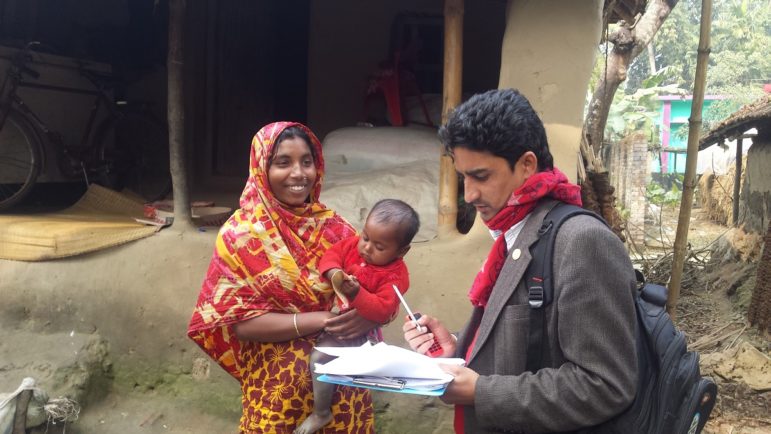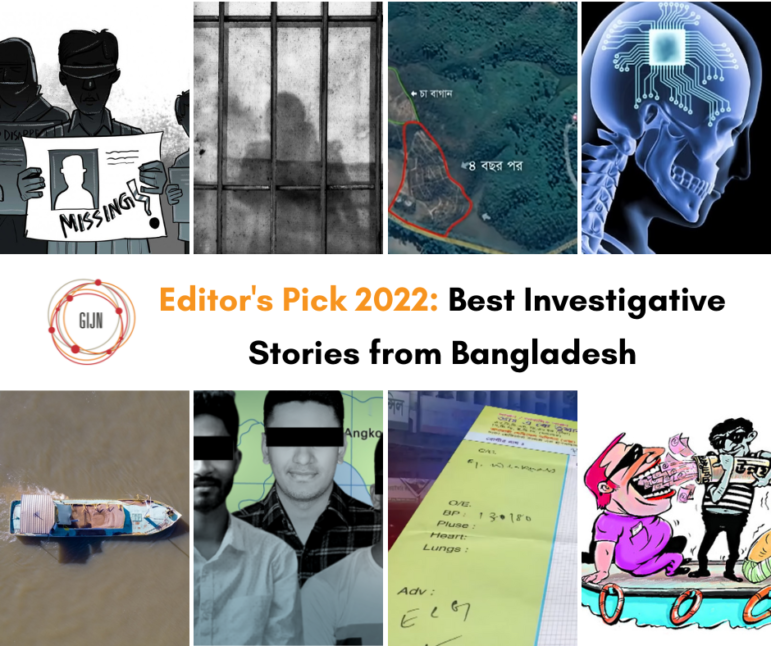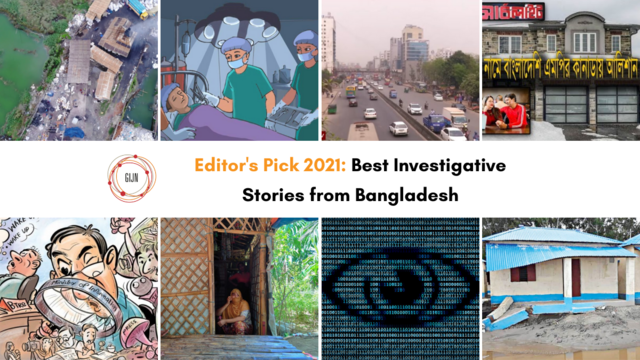

How They Did It: Making a Story Too Big to Ignore by Using Surveys
Read this article in
Old desktop computers, buzzing dot printers, a fax machine, two rows of desks and a few passionate journalists — local newsrooms in Bangladesh all look more or less the same. For their small teams, the arrival of artificial intelligence, data-driven journalism or the use of satellite images is still the stuff of fiction. But sometimes, these small newspapers produce big stories that many mainstream national media have missed. This was the case for Gramer Kagoj, a daily based in Jashore, a district 200 kilometers from the capital Dhaka.
Gramer Kagoj is well known to readers for its reporters’ love of investigative journalism, which has won its team various national awards for quality reporting. While most local newsrooms are struggling to retain their market share in a fight with the heavyweight national dailies, Gramer Kagoj boasts the highest circulation in its district, with 40,000 copies a day.
Its latest big investigation was not about any influential politician, government official or corrupt corporation, but about a system that deprives thousands of pregnant women of the maternity allowance they are supposed to receive from the government because they do not have enough money to feed themselves and their soon-to-be-born baby.
Bangladesh’s government spends almost 14% of its national budget on social safety, which is equivalent to about US$8 billion. The Maternity Allowance Program is one of the major safety net programs, helping 700,000 “ultra-poor” mothers with their nutrition and health needs.

A collage of recently-published Gramer Kagoj stories in their series on maternity allowance.
But the recently-published Gramer Kagoj series revealed that most of the beneficiaries of this program are not poor at all. The team unearthed widespread corruption, negligence of duty, abuse of power and inherent flaws in the policy that allows scope for irregularities.
The investigation took one year to complete. Sixteen reporters traveled to all corners of Jashore district and interviewed 400 mothers. The number 400 was not random in the least — in fact, this number turned out to be crucial to their investigation. But more on that later…
Listening to the Community
As a local newspaper, Gramer Kagoj enjoys deep engagement with the rural communities of Jashore. Its reporters were receiving complaints from village residents that most of the beneficiaries of the maternity allowance program were fake – indeed, that most of them were not pregnant at all. Similar allegations started flowing in from all eight upazillas (sub-districts).
The headline “Fake Mothers” looked very promising. The paper decided to dig deep into the story, as it had great public interest and elements like abuse of power and misuse of public funds. But over the next few months, the investigation took a different turn, revealing a deeper, systemic problem.
The reporters started by filing public records requests (known as RTI requests, for Bangladesh’s Right to Information Act) asking authorities for a complete list of the program’s beneficiaries. They received names, addresses and other details for around 7,500 beneficiaries within a week. “That was a good start,” said Mobinul Islam, the editor of Gramer Kagoj. “But we had no idea what was coming ahead, that the investigation would take so long to complete.”

The small newsroom of Gramer Kagoj, a Bangladeshi daily newspaper in Jashore district. Photo: Gramer Kagoj
Addressing the Big Question
Generally, when journalists report on irregularities in social safety net programs, authorities tend to dismiss these as exceptional cases. The Gramer Kagoj team wondered: How many interviews or case studies would it take to establish that the problem is widespread? For some time, they had been discussing the question of how to make this story so big that nobody could ignore it by saying “these are just exceptions.”
“We have reported on irregularities in social safety programs before and there was hardly any impact,” said Islam. “Corruption is widespread in Bangladesh. Audiences quite regularly see reports on big corruption scandals. They don’t care about small irregularities in districts.”
But they wanted this maternity allowance investigation to have impact, and so decided to go big. The main idea, said Islam, was that “if researchers can interview [a small number of people] and publish national surveys, why can’t Gramer Kagoj do the same?”
Gramer Kagoj asked Mostafizur Rahman, the senior research manager of ResInt, a leading research company in Bangladesh, to help find a solution. His answer came quickly: “Go for a scientific survey.” Some of the reporters were skeptical about mixing surveys with traditional investigative methods. They asked, how do we do both? Rahman replied: “It’s all about methodology.”
Random Is Not Random
Rahman developed a methodology along with the team. The idea was this: Reporters would conduct in-depth journalistic interviews and collect photos, videos and other documents, as they do in other investigations. But there would be some structured questions that every reporter must ask the interviewees. All the answers would later be inserted into a spreadsheet for further analysis.
There was also something very new for the Gramer Kagoj journalists. “You cannot interview whoever you want,” Rahman told the team during a planning meeting in October 2017. “The selection of respondents will be random, and what is random in journalism may not be random in survey methodology.”
The methodology suggested who to interview. “Suppose you have 50 cards. You just pick a card blindly. Again, you pick a second card blindly. Continue this process until your sample size is achieved. This process can be done through a computer, which is called a randomized method,” Rahman said.

Jashore and its eight sub-districts. Source: LGED
Following a statistical formula, the required sample size for this research worked out to 384 beneficiaries, which were rounded up to 400, said Rahman. The journalists divided the whole district in small administrative clusters and statistically calculated the number of mothers to be interviewed, based on total beneficiaries in each cluster.
Data as Evidence
Tackling 400 interviews seemed like too much, said Islam. They only had 18 reporters on staff to produce content for a daily newspaper. “But the excitement was high and there was willingness in the team to do it,” said Islam. They developed eight teams of two people. Each team was responsible for a sub-district, and they worked in rotations.
They gathered videos, photos and documents, along with interviews. The next step was to structure the answers in an Excel spreadsheet. None of the reporters had experience handling large sets of data. Again, Rahman helped the team.
“It was a big challenge for us to orient them with regular research procedure and complete data collection in a proper manner,” he said. “We spent time debriefing them on how data needs to be collected and following a quality check. However, they did this successfully, and we found they were passionate to dig for the facts.”
The findings were something unexpected. Data revealed that their primary hypothesis was wrong. There were almost no “fake mothers,” as was initially thought. Other than a very few exceptions, almost all beneficiaries were real mothers. However, they found that most of these mothers were not poor — and almost one third were rich.
Data Points in a New Direction
This social safety program is for the poorest of the poor, but the data revealed 92% of the beneficiaries did not match that criteria. This was a new angle for the team. There was disaggregated data to show the how much of the social safety funds were going into the wrong hands. They found that local government officials or political leaders were selecting the beneficiaries, either through nepotism or by taking bribes.
The data provided a whole new set of story angles, including fake medical certificates, non-existent NGOs appointed to supervise the program, bank accounts opened with fake signatures and government committees that never met.
The data told the following stories: Most of the mothers never obtained medical certificates, even though certificates were submitted along with their application; none of the beneficiaries ever saw an NGO official visit their house; many of them could not remember going to a bank to open an account; and none of them ever attended any government committee meetings, which were supposed to include beneficiary representatives.
Aminur Rashid, a senior journalist in Dhaka who mentored the team in this project, said, “If the investigation hadn’t been structured like a survey, there was the risk that reporters only interviewed a few fake or rich beneficiaries, finding petty corruption and missing the deep-rooted flaw in the overall system. The mix of scientific survey and investigative reporting techniques revealed a trend and quantified the severity of the problem.”
Pushing for More
New angles required further investigation. Gramer Kagoj filed RTI requests for committee meeting records, lists of NGOs being paid for supervision, documents about the beneficiaries submitted to government offices, and more.
The team needed to visit the field again. This time, they had a solid storyline, definite targets and public documents to prove allegations made by the beneficiaries. They identified corrupt officials and politicians, reached out to NGO offices only to find that they were either non-existent or not in operation, and found new cases where banks allowed maternity allowances to be deposited in male customers’ accounts.
“We had to face a lot of pressure during this investigation,” said Islam. “These local leaders are connected with influential politicians. We got many phone calls and requests to stop the investigation because the national election was approaching. And these rural leaders are important in vote politics.”
Not Ignored
In December 2018, Gramer Kagoj published more than 10 reports. They exposed the ineffective policy and systemic corruption, and held the relevant public institutions accountable, including NGOs, banks, local governments, hospitals and administrative offices.
The series garnered a huge amount of attention in Jashore. As it unfolded, more information started to flow in from local sources on other social safety schemes. Meanwhile, local authorities committed to reforming the beneficiary selection process, and even senior political leaders told reporters they would ensure that mothers who were actually poor were included on the beneficiary list.
“I would say the impact is more social,” said Islam. “There is a deep understanding among the officials and leaders that it is wrong to give poor mothers’ allowance to the rich families, something they overlooked for years. It is that change of feeling, that awareness, that the investigation has brought.”
He believes this change in mindset is only because the story was too big to ignore, and no one could challenge the data-driven findings. The Gramer Kagoj team went on to use the same investigation method in the following months to uncover abuse in two other social safety schemes.
 Miraj Ahmed Chowdhury is the editor of GIJN in Bangla. He also oversees programs and communications at the Management and Resources Development Institute (MRDI), a leading media development organization and GIJN member in Bangladesh. He has 14 years of experience in journalism, mainly in broadcast.
Miraj Ahmed Chowdhury is the editor of GIJN in Bangla. He also oversees programs and communications at the Management and Resources Development Institute (MRDI), a leading media development organization and GIJN member in Bangladesh. He has 14 years of experience in journalism, mainly in broadcast.









